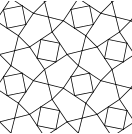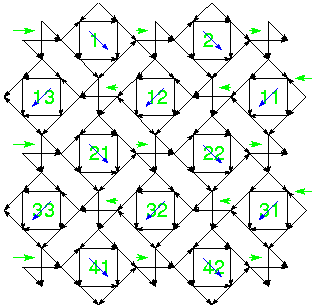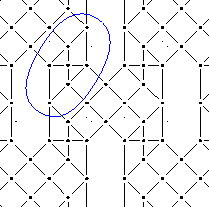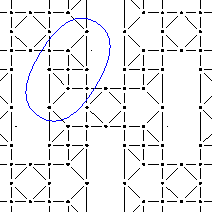Droste
Contents
Introduction
On this page, several grounds are made with the “Droste-effect”: reuse thread diagrams as pair diagrams. Some of these, like “Wobble” can only be made by GroundForge using this technique.
See the Groundforge help-page Droste-effect for more information.
Some of the examples have forms to make playing easier.
Other examples only have plain links for multi-step patterns, you need to click the  in the advanced section for the diagrams of the second (or even third) step.
in the advanced section for the diagrams of the second (or even third) step.
Below some less trivial stitches to copy-paste into a form-field, drop or add twists at will. Each second string is the mirrored version of the displayed stitch. Note that the last two images are two stitches each with a pin left out, these siamese twins show up as one stitch in the pair diagrams.

clcrct

crclcrc


ctcrctc

ctcrclctc


tctctrrctctl
Fish
Double fish B2,S2,W3 (see page fish)
also can be defined in two steps using the thread diagram of the first step as pair diagram for the second step. Please replace cross b102 in the thread diagram of step-2 with a half knot or two to mimic a twisted pair.
The thread diagram of the second step can reused again: click the  below the second step fish.
below the second step fish.
The same result as this 3-step fish can be achieved in two steps.
Defining a footside will become problematic, as we have four workers going into the same direction before returning. In practice you can bend this rule and change direction every other row, provided that plain twists separate the fish. Note that in both cases it can take a while for the last steps to appear.
Please note the resemblance of the 3-step fish with the narrow eyed spider.
Wobble
This ground uses the thread diagram of alternating ct/ctct as pair diagram.
Pricking

 The left pricking is generated with one of the “ground from template”
tools
and a plain text file (download).
The changing angle of the rose ground units inspired the name.
The left pricking is generated with one of the “ground from template”
tools
and a plain text file (download).
The changing angle of the rose ground units inspired the name.
On the right a distorted version that matches a Torchon grid. The units of the rose-ground are placed in different directions, indicated with blue arrows. These units can be replaced with units of a bias ground. The green numbers and arrows indicate the working order inherited from the first pair diagram.
Generate diagrams (color coded / threads)
After completing the stitches for the second step in the form below,
click on the button of the desired type of rose-ground units.
In the page that will appear next, click the  in the advanced section for the thread diagram.
in the advanced section for the thread diagram.
Paris
 The Paris ground uses the thread diagram of the half stich as pair diagram.
Some variations on the Paris ground are in the Whiting index (defined without this Droste technique) A5, A6, B5, A7-H7, G11.
The Paris ground uses the thread diagram of the half stich as pair diagram.
Some variations on the Paris ground are in the Whiting index (defined without this Droste technique) A5, A6, B5, A7-H7, G11.
In turn the fancy Zeccatello uses the thread diagram of a Paris variation as pair diagram: single-step, two-step definitions.
Note that the cloth stitch units are in fact a unit of a bias ground.
The picture on the right shows a general scheme. The stitches of the Paris ground are replaced with units. In the picture, one unit is indicated with a blue ellipse. The buttons below replace this unit with the unit shown on the button, and the unit to the right with its mirrored version.
 The picture on the right shows another general scheme also based on the Paris ground. The stitches of the Paris ground are replaced with units. In the picture, one unit is indicated with a blue ellipse. The buttons below replace this unit with the unit shown on the button, and the unit to the right with its mirrored version.
The picture on the right shows another general scheme also based on the Paris ground. The stitches of the Paris ground are replaced with units. In the picture, one unit is indicated with a blue ellipse. The buttons below replace this unit with the unit shown on the button, and the unit to the right with its mirrored version.
Mrs. V. Irvine has worked an example using the left pricking. See Favourite Flaveolate for a photo, and here for how she made it (one step definition). Pins where used to get the triangle shape at the “joints” of the hexagons.
More examples
"&" ground
The following examples use a stitch like crctclcr in the first step. The first step of example 1 is interesting: every single tread takes the same path!








